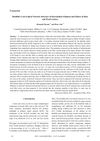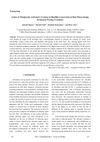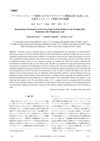TLDR Permanent wave treatment with thioglycolic acid changes hair structure by altering disulfide bonds.
The study investigated the structural changes in human hair induced by permanent wave treatment using thioglycolic acid (TGA) and sodium bromate. By applying rubber elasticity theory to the force-extension curves of treated hair fibers, researchers identified key structural parameters, including the number of intermolecular disulfide (SS) bonds in intermediate filament (IF) proteins, the volume fraction of matrix protein, and the shape of the matrix domain. The findings revealed that TGA preferentially attacked SS bonds between globular matrix proteins over those between IF proteins, leading to a shape change in the matrix domain from ellipsoidal to near-spherical.
 3 citations
,
January 2009 in “Sen'i Gakkaishi”
3 citations
,
January 2009 in “Sen'i Gakkaishi” Using both TGA and DTDG in hair straightening reduces hair damage compared to using TGA alone.
272 citations
,
September 2001 in “Journal of Biological Chemistry” Human hair keratins were cataloged, showing their roles in hair differentiation stages.
11 citations
,
September 1996 in “Journal of applied polymer science” Potassium cyanide treatment changes hair's disulfide bonds, making it more elastic.
 4 citations
,
January 2015 in “Sen'i Gakkaishi”
4 citations
,
January 2015 in “Sen'i Gakkaishi” Hair and wool strength is affected by the number and type of bonds in their protein structures, with hair having more protein aggregates than wool.
53 citations
,
July 2016 in “Cosmetics” Future hair cosmetics will be safer and more effective.
 18 citations
,
January 2008 in “Sen'i Gakkaishi”
18 citations
,
January 2008 in “Sen'i Gakkaishi” Thioglycolic acid and L-cysteine change hair structure differently during perms, affecting hair strength and curling efficiency.
 2 citations
,
January 2015 in “Sen'i Gakkaishi”
2 citations
,
January 2015 in “Sen'i Gakkaishi” Washing permed hair after using thioglycolic acid helps reform strong bonds, making hair stronger.
 8 citations
,
January 2009 in “Transactions of the Materials Research Society of Japan”
8 citations
,
January 2009 in “Transactions of the Materials Research Society of Japan” Water-soluble wool keratin can protect human hair from damage during treatments.




